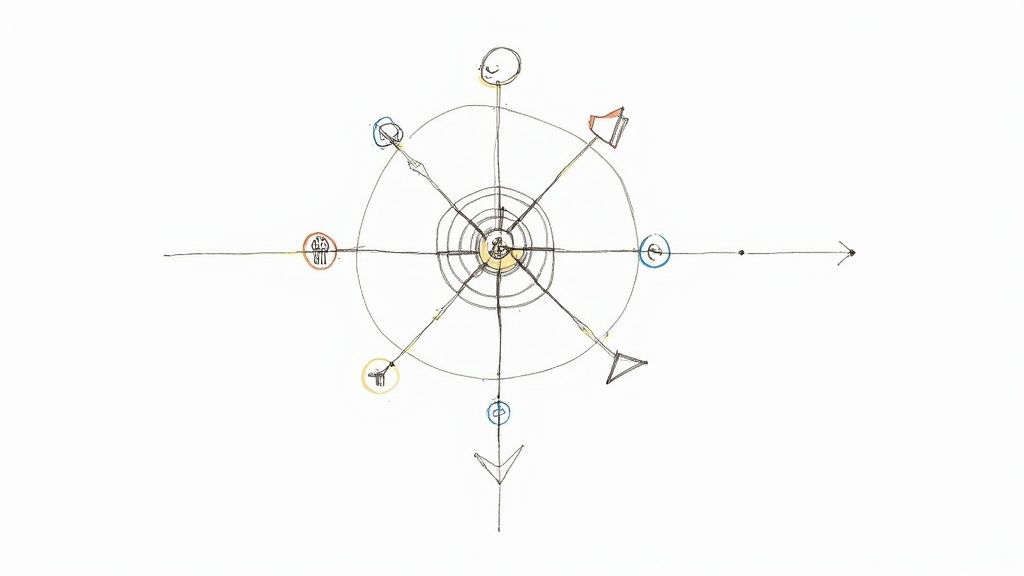
How to Increase Brand Awareness with Modern Strategies
Want to boost brand awareness? You need a brand that sticks. It’s all about creating a memorable identity and a trustworthy personality that clicks with your audience instantly. This foundation is what makes every marketing dollar you spend work harder, weaving together a brand story that people won't forget.
Building a Brand People Actually Remember
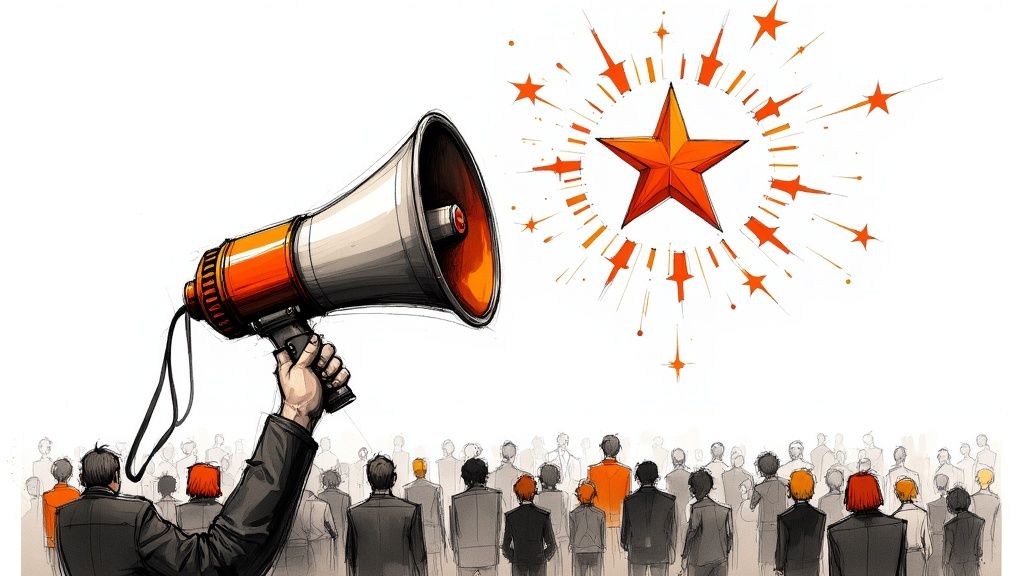
Before you can get your message out there, you need a message people care about. Pushing for more brand awareness isn't just about being the loudest voice in the room. It’s about making sure people remember you long after they’ve scrolled past. This means going beyond just a logo and a catchy slogan to build a brand with a real personality and a reputation for being reliable.
Today’s customers are looking for more than a transaction; they want a connection. They want to trust you. In fact, a staggering 81% of consumers say they need to trust a brand before they even think about buying from it. That single statistic changes the entire game—trust isn't a nice-to-have anymore. It's the price of entry.
Define Your Core Identity
Your brand's identity is its heart and soul. It’s what you stand for, the way you talk, and the feeling you leave people with. Think of it as your brand's unique personality. Are you witty and a little rebellious like Wendy's on Twitter, or are you all about inspiration and empowerment like Nike?
Figuring this out means answering a few big questions:
- What’s your mission? Dig deeper than just "selling stuff." What bigger purpose do you serve for your customers?
- What are your core values? These are the principles that guide every single decision, from how you build your product to how you handle a customer complaint.
- What’s your unique voice? Nail down your tone. Is it formal and professional? Casual and friendly? This voice needs to show up consistently, everywhere.
Getting clear on this ensures that every tweet, blog post, or video script feels genuinely you and strengthens who you are.
Craft a Consistent Visual Experience
We're visual creatures. More often than not, a person's first impression of your brand is shaped by what they see, not what they read. A consistent visual identity is what makes your brand instantly recognizable, whether someone lands on your website, sees your social media profile, or unboxes your product.
A strong visual system doesn't just make you look good; it builds familiarity. When customers see your specific shade of blue or your unique font, they should instantly think of you. This cognitive shortcut is crucial for cutting through the noise.
Think about the key pieces that make up your visual brand:
- Logo: Keep it simple, memorable, and make sure it looks good whether it's tiny on a phone screen or huge on a billboard.
- Color Palette: Pick a primary and secondary color scheme that brings out the right emotions for your brand.
- Typography: Use consistent fonts for your headlines and body text that reflect your brand’s personality.
- Imagery Style: Decide on a defined style for your photos and graphics. Are you vibrant and energetic, or more minimalist and calm?
These elements all work in harmony to create a cohesive look that reinforces your brand identity at every single touchpoint.
Make Your Brand Tangible
While your digital strategy is key, don't ever underestimate the power of a physical connection. Tangible items can leave a lasting impression that a digital ad rarely can. Thoughtfully chosen custom promotional giveaways can play a huge role here, making your brand memorable and building real connections.
Think about it: a high-quality, genuinely useful item with your branding on it creates a positive, long-term association in a customer’s mind every time they use it.
Mastering the Channels Where Brands Get Discovered
Your potential customers don’t live on a single platform, and your brand shouldn't either. To really boost brand awareness, you need a smart, multi-channel strategy that meets people where they already hang out. It’s no longer about picking one channel and calling it a day; it's about creating a seamless presence across the many touchpoints that make up a modern customer's journey.
The path to brand discovery is more fragmented than ever. In fact, recent data shows the average internet user now finds new brands through nearly 5.8 different sources. That single stat tells a critical truth: a siloed approach is a recipe for being ignored. Your strategy has to be integrated, ensuring your message is consistent but still feels native to each channel.
Prioritizing Your Digital Footprint
While there are tons of channels, they aren't all created equal. Search engines are still a dominant force, with 32.8% of consumers using them to find new brands. This makes a strong SEO and content marketing foundation completely non-negotiable. When someone has a problem, you want your brand to be the solution they find first.
This goes way beyond just keyword research. It’s about creating genuinely helpful content that answers real questions, solves problems, and quietly establishes your authority. Think blog posts, in-depth guides, and—increasingly—video. Video, especially, is a powerful way to connect and educate at the same time.
The table below breaks down where consumers are most likely to find new brands. Use it to gut-check your own channel priorities.
Top Channels for Brand Discovery
Source: Digital 2024 Global Overview Report
As you can see, digital channels are neck-and-neck with some very traditional ones, which highlights the need for a truly integrated strategy.
The sheer scale of the audience you can tap into on social media is staggering, as this image illustrates.
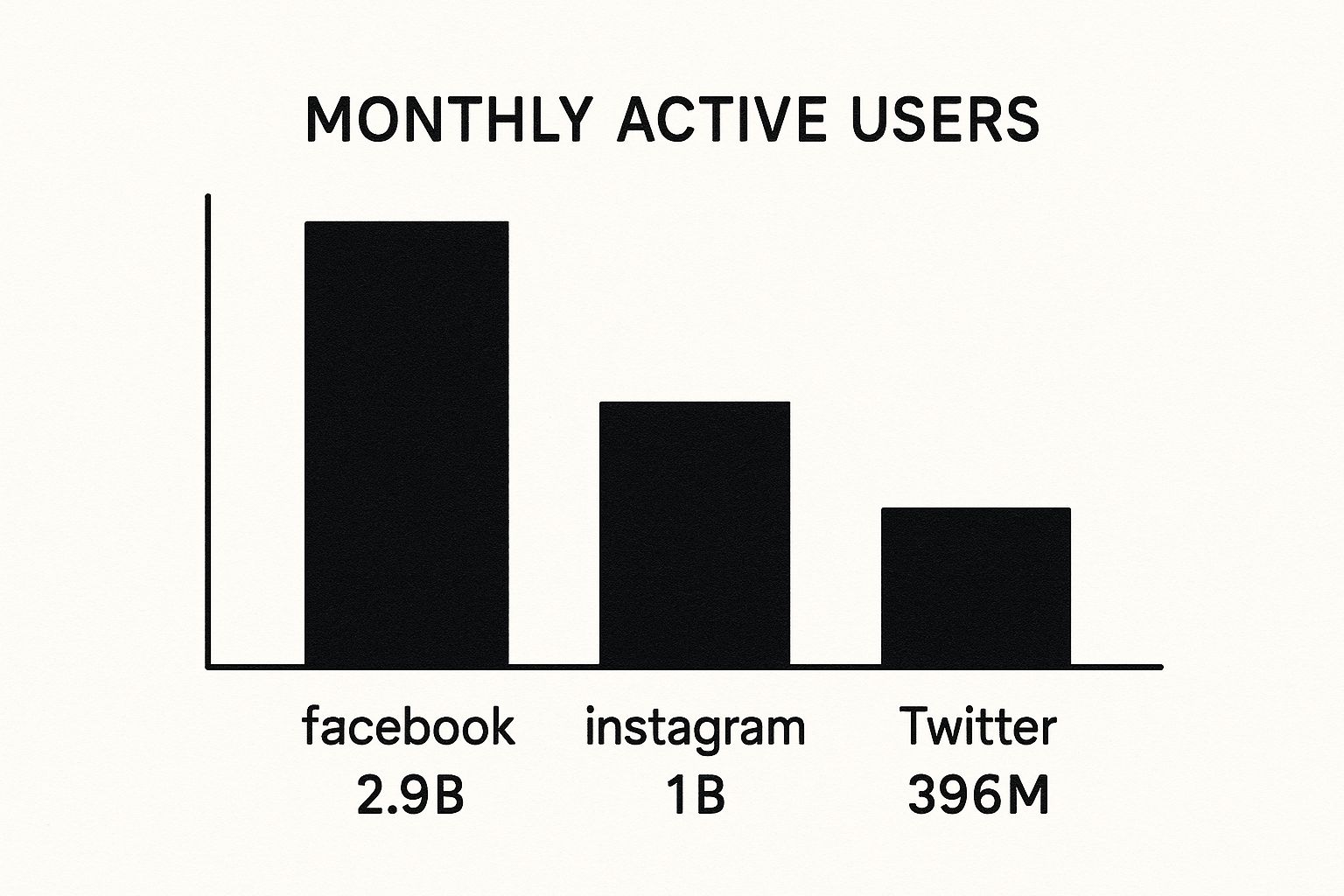
Platforms like Facebook, Instagram, and YouTube aren't just for ads; they are discovery engines in their own right. This is where communities form, trends catch fire, and brand personalities are built. Your goal is to be an active participant, not just a broadcaster. Share valuable stuff, jump into conversations, and show the human side of your brand.
Your multi-channel strategy shouldn't feel like you're just repeating the same message everywhere. It's about telling a cohesive brand story, with each channel adding a unique chapter. What works on TikTok won't necessarily resonate on LinkedIn, and that's okay.
Integrating Online and Offline Worlds
Even with all the focus on digital, don't sleep on traditional channels. A surprising 32.3% of consumers still discover brands through TV ads, proving that offline media absolutely retains its influence.
The key is integration. A TV ad can drive viewers to a specific landing page, or a print ad can feature a QR code that leads straight to an interactive experience.
Here’s how you can start building a more connected multi-channel plan:
- Map the Customer Journey: Get a clear picture of all the potential touchpoints where someone might encounter your brand, both online and off.
- Allocate Resources Smartly: You don't need to be everywhere at once. Focus your budget and effort on the channels your target audience actually uses.
- Create Connected Campaigns: Keep your messaging and visuals consistent, but tailor the delivery. An Instagram Story should feel different from a detailed blog post.
One powerful tactic for bridging this gap is interactive video. A single video can be embedded on your blog, shared on social media, and linked in email campaigns. By adding interactive elements with a tool like Mindstamp, you turn passive viewing into an active experience.
For more on this, check out our guide on using interactive video to supercharge your content marketing for some practical tips.
Ultimately, mastering the channels of discovery is about being present, consistent, and relevant. When you understand where your audience spends their time and create a unified brand experience, you ensure that no matter where they find you, the impression you leave is a memorable one.
2. Create Interactive Content That Builds Community
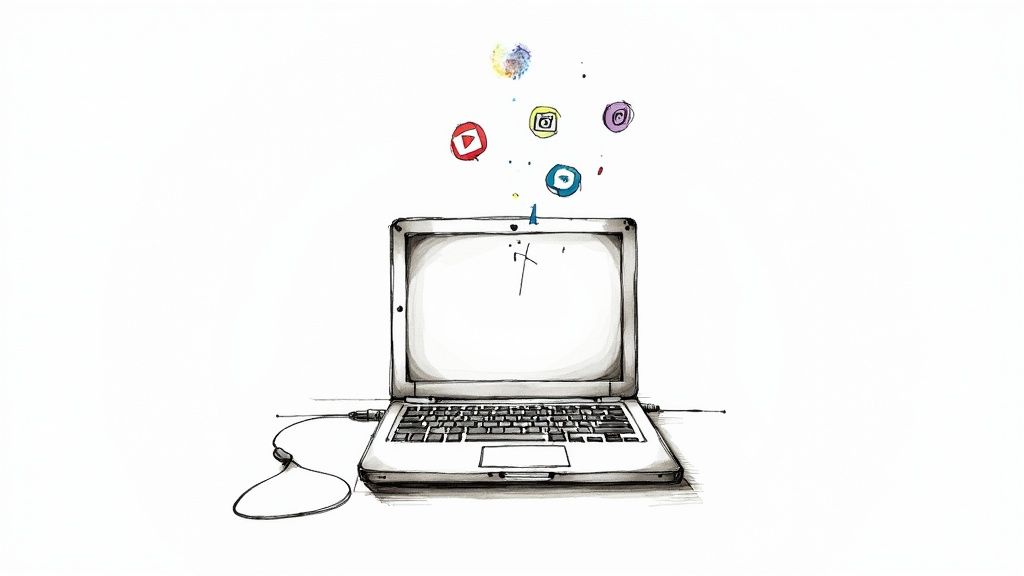
Let's be honest: most content gets scrolled past in a blur. If you really want to grab attention and build brand awareness, you have to do more than just publish—you have to invite people to participate.
This is where interactive content becomes your secret weapon. By making your audience a part of the story, you’re not just telling them about your brand; you’re letting them experience it. This shift from a one-way broadcast to a two-way conversation is how you build a real community.
Move Beyond Passive Scrolling
Think about most content marketing. You create a blog post or a video, push it out, and hope for the best. It’s a one-way street. Interactive content flips that script by asking for a little something from the user to move forward.
This simple change makes a world of difference. It boosts engagement, makes your brand more memorable, and gets people talking. When someone invests even a few seconds of their time to interact, it creates a much stronger mental connection with your brand.
Here are a few great ways to get started:
- Quizzes and Assessments: These are fantastic for helping people understand a problem or learn something new. A B2B software company could have a "What's Your Team's Productivity Score?" quiz that points out common workflow bottlenecks.
- Polls and Surveys: Give your audience a voice and get priceless feedback in return. You can let them vote on the next feature to build, ask their opinion on an industry trend, or just start a fun debate.
- Calculators: If what you offer has a clear, quantifiable benefit, a calculator is a no-brainer. Think of a marketing agency with an ROI calculator or a solar company with a savings estimator. These aren't just fun toys; they provide real value.
Take Engagement Deeper with Interactive Video
Video is already king when it comes to engagement, but you can take it to a whole new level by adding interactive elements. Instead of a video that just plays from start to finish, you can create a dynamic, choose-your-own-path experience.
Platforms like Mindstamp make it surprisingly simple to drop clickable hotspots, questions, and branching logic right into your videos, turning them from passive assets into powerful conversation tools.
Just imagine:
- A clothing brand could create a "Shop the Look" video where viewers click on outfits to see product details and buy them without ever leaving the player.
- A SaaS company could build an interactive product tour where a user clicks on the features they care about most, getting a demo that’s perfectly tailored to their needs.
- A nonprofit could use a branching video to show the direct impact of a donation. Viewers could choose where their money goes and see the powerful outcome of their decision.
When you put the viewer in the driver's seat, you capture their attention in a way a standard video just can't. It turns a monologue into a dialogue and makes your message stick.
The best part? You get incredible data on what your audience actually cares about. You can see which paths they followed, what products they clicked on, and where they spent the most time.
Turn Interaction into a Thriving Community
Ultimately, the goal here is to build a tribe of advocates who feel genuinely connected to your brand and to each other. The data you get from interactive content isn't just for your internal spreadsheets—it's fuel for more conversations.
When you run a poll, don't just keep the results to yourself. Share them! Talk about what they mean. If a quiz uncovers a common challenge for your audience, create content that solves that exact problem. This is how you show people you’re listening.
By consistently creating these kinds of valuable, interactive experiences, you give people a reason to come back, to share, and to feel like they’re part of your brand's story. That’s how you build brand awareness that lasts.
Of course. Here is the rewritten section, crafted to sound human-written and match the expert tone from your examples.
Using Social Proof and Partnerships to Grow Faster
While creating your own content is absolutely essential, some of the most powerful marketing you’ll ever get won't come from you at all. It comes from the people who already know and love your brand.
By tapping into social proof and building smart partnerships, you can borrow trust and get in front of audiences that would otherwise take years to build on your own. It's all about letting others tell your story for you.
Your most credible advertisers are your happiest customers. When a potential buyer sees real people genuinely excited about your product, it carries so much more weight than any polished ad ever could. That's the power of user-generated content (UGC)—the photos, videos, reviews, and social media posts your community creates. It’s authentic, relatable, and incredibly persuasive.
Harness the Power of User-Generated Content
Encouraging customers to create and share content about their experiences is a cornerstone of modern brand awareness. It essentially turns your customer base into a volunteer marketing army. People trust other people, and seeing someone like them enjoy your product is a potent endorsement that branded messages just can’t replicate.
Recent branding studies back this up, showing that consumers find user-generated content 50% more trustworthy and 20% more influential than other media. Plus, with two-thirds of US consumers saying their social values impact their buying decisions, authentic customer stories can give your brand’s appeal a major boost. You can find more insights on branding statistics and consumer trust over at Blacksmith.agency.
So, how do you get the ball rolling?
- Launch a Branded Hashtag Campaign: Create a simple, memorable hashtag and encourage customers to use it when they post. Feature the best ones on your official channels to get people excited.
- Run a Contest or Giveaway: Ask users to submit photos or videos with your product as their entry. This is a fantastic way to generate a wave of UGC while boosting engagement.
- Feature Customer Stories: Make it a regular habit to highlight the best UGC on your social media, website, and even in your email newsletters. This not only rewards the creators but also inspires others to join in.
Just remember to always ask for permission before you repost a customer's content. A quick, friendly DM is all it takes and shows you respect your community.
Forge Strategic and Authentic Partnerships
Looking beyond your customers, collaborating with other brands and creators can introduce you to entirely new—and highly relevant—audiences. The trick is to find partners whose values and audience truly align with yours. The collaboration needs to feel natural, not like a forced ad.
This isn’t about shelling out big bucks for a massive celebrity to do a one-off post. It's about building real relationships with the right collaborators who can genuinely help increase your brand awareness.
Types of Partnerships to Explore
When you start collecting UGC, you're not just getting free marketing material; you're building a library of authentic endorsements. This content is perfect for repurposing. For instance, you could compile customer video testimonials into an interactive highlight reel, adding clickable calls-to-action that lead right to your product pages. To get that part right, check out our guide on the importance of adding a CTA to videos.
How to Actually Measure Brand Awareness
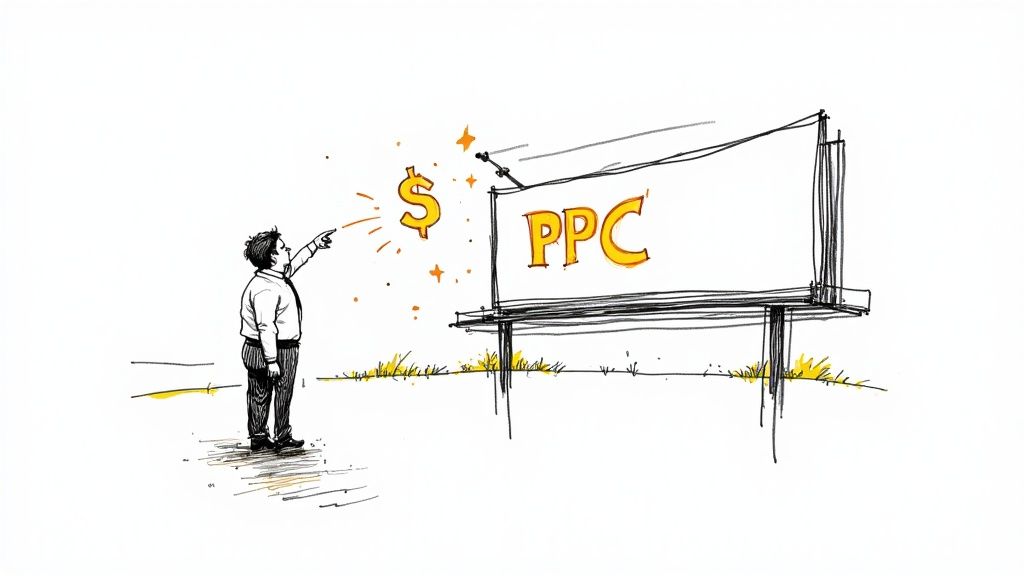
Pouring time and money into brilliant campaigns feels great, but how do you know if it’s actually working? If you can’t measure the impact of your brand awareness efforts, you're flying blind. It's time to move beyond simple vanity metrics and focus on the data that truly signals growth and proves your strategy is delivering real value.
Effective measurement isn’t about finding a single, magic number. It’s about looking at a collection of indicators that, together, paint a clear picture of your brand's growing presence. This data-driven approach is what lets you see what’s working, what isn’t, and where to put your resources for the biggest impact.
Moving Beyond Vanity Metrics
The first step is learning to tell the difference between metrics that feel good and metrics that are good. High follower counts or post likes are encouraging, sure, but they don't always translate into genuine brand awareness. Instead, we need to focus on metrics that reflect a deeper level of consumer recognition and intent.
These more meaningful KPIs fall into two main camps: quantitative data (the "what") and qualitative data (the "why").
- Quantitative Metrics: These are the hard numbers you can track over time. Think website traffic, search volume, and social media reach. They give you a clear, numerical baseline to gauge progress.
- Qualitative Metrics: This is all about the sentiment and conversation surrounding your brand. It includes social media comments, product reviews, and unprompted mentions. This data gives you context and helps you understand how people actually perceive your brand.
By combining both, you get a much richer and more accurate view of your brand's health.
Key Metrics for Tracking True Awareness
To get a real sense of your brand’s footprint, you need to track specific KPIs consistently. These metrics directly reflect how often people are thinking about, searching for, and talking about your brand. I recommend setting up dedicated dashboards in your analytics tools to keep a close eye on these key indicators.
Direct Website TrafficThis is one of the strongest signals you can get. Direct traffic happens when someone types your URL right into their browser or clicks a bookmark. They didn't come from a Google search or a social media link; they came to you on purpose because your brand was already on their mind. An upward trend here is a fantastic sign that your brand recall is growing.
Branded Search VolumeHow many people are punching your brand name or products straight into Google? You can track this with tools like Google Search Console or Semrush. A steady increase in branded search volume means more people are actively seeking you out—a direct result of successful brand-building.
Tracking branded search volume isn't just for ego; it’s a direct measure of brand salience. When people search for you by name, you’ve officially moved from being an option to being the option they want to explore.
Social Media Reach and MentionsLook beyond likes and dig into reach and share of voice. Reach tells you how many unique users saw your content. More importantly, using a social listening tool like Brand24 lets you track every mention of your brand across the web—even when you aren't tagged. Monitoring the volume and sentiment of these conversations reveals just how far your brand's influence is spreading organically.
Interactive content, like video, offers even deeper insights. You can measure not just views, but how viewers interact. For a detailed guide on what to track, exploring the key video engagement metrics provides a clear path to understanding your audience's behavior.
By consistently tracking these core metrics, you transform measurement from a guessing game into a strategic tool. This data empowers you to refine your campaigns, justify your marketing spend, and build lasting brand equity with confidence.
Answering Your Top Brand Awareness Questions
Even with the best strategy in place, you’re bound to hit a few roadblocks or have questions pop up. It's totally normal. Most marketers bump into the same challenges when they're trying to grow a brand's footprint.
Let's break down some of the most common questions I hear. Getting these answers right can be the difference between a campaign that fizzles out and one that builds real, lasting momentum.
How Long Does It Take to See Results?
This is always the first question, and the only honest answer is: it depends. Think of brand awareness as a long-term investment, not a quick flip. You might see some encouraging signs within the first one to three months—like a little bump in social media chatter or more people typing your URL directly into their browser.
But for most businesses, getting to that point of significant, measurable brand recall usually takes a solid 6 to 12 months of consistent work. The timeline really hinges on a few key things:
- Budget & Intensity: A well-funded, aggressive campaign hitting multiple channels is obviously going to move the needle faster than a slower, purely organic approach.
- Market Competition: If you're trying to make a name for yourself in a crowded space, it’s going to take more time and a lot more creativity to stand out.
- Creative Punch: A truly killer message that connects with your audience can shortcut the process in a big way.
The real key here is patience. Stick to your plan, be persistent, and keep your eye on those early indicators like branded search queries and social mentions. They'll let you know you’re moving in the right direction.
Brand Awareness vs. Lead Generation: What’s the Difference?
It’s easy to mix these two up, but they play very different roles in your marketing funnel. Getting the distinction right is crucial for setting clear goals and knowing what success actually looks like.
Brand awareness is all about the top of the funnel. The goal is simple: get your target audience familiar with who you are, what you’re about, and how you solve their problems. You’re planting seeds and building trust for the long haul. Success here is measured in recall and positive feelings toward your brand.
Lead generation, on the other hand, lives further down the funnel. It's about turning that awareness into active interest by getting a potential customer to raise their hand and give you their contact info. The goal is to pinpoint people who are showing real buying intent.
Here’s a simple way to look at it: Brand awareness is getting people to know your name. Lead generation is getting them to give you their number. When you have strong brand awareness, lead gen becomes so much easier and cheaper because people already know and trust you.
Can Small Businesses Actually Boost Brand Awareness?
Absolutely. You don’t need a massive budget to make a huge impact. In fact, small businesses have a secret weapon: they can be more creative, focused, and authentic than their giant competitors. You might not be able to outspend them, but you can definitely out-niche, out-care, and out-maneuver them.
The trick is to stop trying to be everything to everyone. The most successful small businesses I've seen go deep, not wide. They pick a specific audience and become the absolute go-to solution for that group’s problems.
Here are a few budget-friendly tactics that punch way above their weight:
For a small business, the secret sauce is just being consistently helpful and real. When you deliver incredible value to a tight-knit audience, you’ll build a brand people remember—no blockbuster budget required.
Ready to turn passive viewers into active community members? Mindstamp makes it easy to create interactive video experiences that capture attention, gather data, and build a brand people remember. Explore how Mindstamp can transform your content strategy.
Get Started Now
Mindstamp is easy to use, incredibly capable, and supported by an amazing team. Join us!



Try Mindstamp Free










